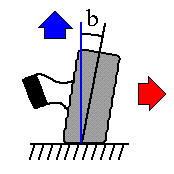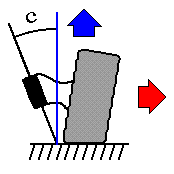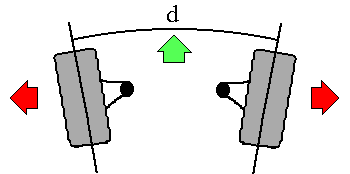
![]()

![]()
Wheels are three-dimensional items and so they can turn in many positions. Their relative position to the car or tracking depends on four different angles.
In the images, the angles have been increased to be easily seen. The red arrows point to the outer of the car (right or left sides), the green ones always to the front of the car and the blue ones to the top of the car.
Caster angle (a)
|
 |
Camber angle (b)
|
 |
Steering axis inclination (c)
|
 |
Toe-out (d)
|
 |
Wheels are identified with some number, for example for the standard GTT one, of the kind:
| 5.5 | J | 13 | ET | 36 |
| Width | Edge shape | External diameter | Offset |
The wheel width (5.5) and diameter (13) are given in inches. The rim shape (J) is a code and the offset (36), in mm, that is usually NOT written, is the distance between the central plane that would divide wheel tyre width in two equal parts and the parallel plane of the hub surface. A positive number here means that the hub surface is more external than the middle wheel plane, so as ET decreases and even becomes negative the track width increases.
Renault wheels (included the GTT standard one) usually have ET 36 mm. The Cup version wheels enlarged 40mm the track width being the same width (5.5 B 13) because they had ET 16 mm.
Another data in the wheel is the bolt data or PCD. For the GTT:
| 100 | x | 4 |
| Bolt location | Number of bolts |
The bolt location is the diameter of the circle made with the bolt centers, in mm. The last parameter that you can specify on a wheel is the centre bore diameter. It's 60.1 mm for the GTT hubs (And Renault in general).
Tyres are also identified by a number, for example for the standard GTT tyre, like:
| 175 | / | 60 | R | 13 | 76 | H |
| Width | Profile | Radial | Inner diameter | Charge code | Speed code |
The tyre width (175) is given in mm, while the inner tyre diameter (13) is given in inches. The tyre profile (60) is specified as the % of the tyre width. The speed (H) codes are chosen from a table:
| Speed code | R | S | T | U | H | V | W | Z |
| Max speed (km/h) | 170 | 180 | 190 | 200 | 210 | 240 | 270 | +270 |
The charge (76) codes are also chosen from a table:
| Charge code | 60 | 61 | 62 | 63 | 64 | 65 | 66 | 67 | 68 | 69 |
| Max weight (kg) | 250 | 257 | 265 | 272 | 280 | 290 | 300 | 307 | 315 | 325 |
| Charge code | 70 | 71 | 72 | 73 | 74 | 75 | 76 | 77 | 78 | 79 |
| Max weight (kg) | 335 | 345 | 355 | 365 | 375 | 387 | 400 | 412 | 425 | 437 |
| Charge code | 80 | 81 | 82 | 83 | 84 | 85 | 86 | 87 | 88 | 89 |
| Max weight (kg) | 450 | 462 | 475 | 487 | 500 | 515 | 530 | 545 | 560 | 580 |
| Charge code | 90 | 91 | 92 | 93 | 94 | 95 | 96 | 97 | 98 | 99 |
| Max weight (kg) | 600 | 615 | 630 | 650 | 670 | 690 | 710 | 730 | 750 | 775 |